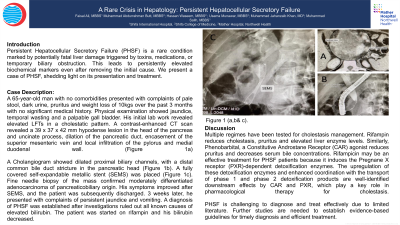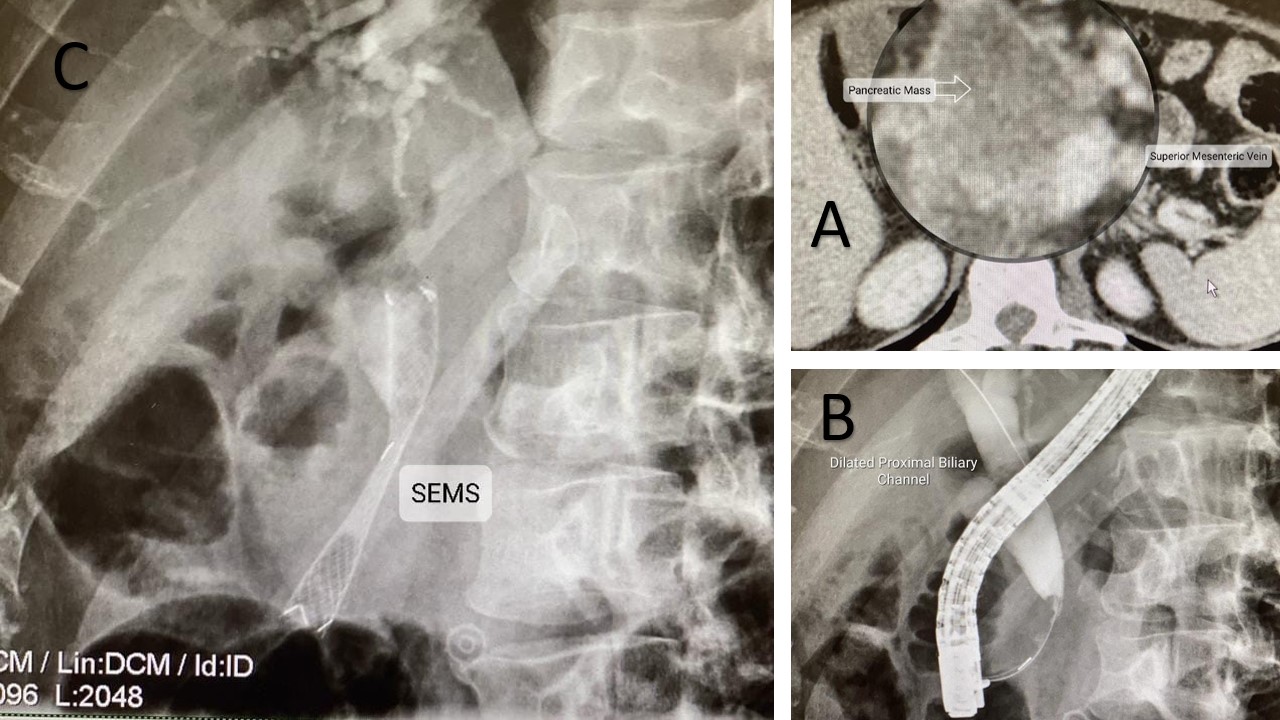Tuesday Poster Session
Category: Liver
P4794 - A Rare Crisis in Hepatology: Persistent Hepatocellular Secretory Failure
Tuesday, October 29, 2024
10:30 AM - 4:00 PM ET
Location: Exhibit Hall E


Muhammad Jahanzaib Khan, MD
Mather Hospital, Northwell Health
New York, NY
Presenting Author(s)
Faisal Ali, MBBS1, Muhammad Abdurrahman Butt, MBBS2, Hassan Waseem, MBBS3, Usama Munawar, MBBS2, Muhammad Jahanzaib Khan, MD4, Mohammad Salih, MBBS1
1Shifa International Hospital, Islamabad, Islamabad, Pakistan; 2Shifa College of Medicine, Islamabad, Islamabad, Pakistan; 3Shifa College of Medicine, Islamabad, Federally Administered Tribal Areas, Pakistan; 4Mather Hospital, Northwell Health, New York, NY
Introduction: Persistent Hepatocellular Secretory Failure (PHSF) is a rare condition marked by potentially fatal liver damage triggered by toxins, medications, or temporary biliary obstruction. This leads to persistently elevated biochemical markers even after removing the initial cause. We present a case of PHSF, shedding light on its presentation and treatment.
Case Description/Methods: A 65-year-old man with no comorbidities presented with complaints of pale stool, dark urine, pruritus and weight loss of 10kgs over the past 3 months with no significant medical history. Physical examination showed jaundice, temporal wasting and a palpable gall bladder. His initial lab work revealed elevated LFTs in a cholestatic pattern. A contrast-enhanced CT scan revealed a 39 x 37 x 42 mm hypodense lesion in the head of the pancreas and uncinate process, dilation of the pancreatic duct, encasement of the superior mesenteric vein and local infiltration of the pylorus and medial duodenal wall. (Figure 1a)
A Cholangiogram showed dilated proximal biliary channels, with a distal common bile duct stricture in the pancreatic head (Figure 1b). A fully covered self-expandable metallic stent (SEMS) was placed (Figure 1c). Fine needle biopsy of the mass confirmed moderately differentiated adenocarcinoma of pancreaticobiliary origin. His symptoms improved after SEMS, and the patient was subsequently discharged. 3 weeks later, he presented with complaints of persistent jaundice and vomiting. A diagnosis of PHSF was established after investigations ruled out all known causes of elevated bilirubin. The patient was started on rifampin and his bilirubin decreased.
Discussion: Multiple regimes have been tested for cholestasis management. Rifampin reduces cholestasis, pruritus and elevated liver enzyme levels. Similarly, Phenobarbital, a Constitutive Androstane Receptor (CAR) agonist reduces pruritus and decreases serum bile concentrations. Rifampicin may be an effective treatment for PHSF patients because it induces the Pregnane X receptor (PXR)-dependent detoxification enzymes. The upregulation of these detoxification enzymes and enhanced coordination with the transport of phase 1 and phase 2 detoxification products are well-identified downstream effects by CAR and PXR, which play a key role in pharmacological therapy for cholestasis.
PHSF is challenging to diagnose and treat effectively due to limited literature. Further studies are needed to establish evidence-based guidelines for timely diagnosis and efficient treatment.

Disclosures:
Faisal Ali, MBBS1, Muhammad Abdurrahman Butt, MBBS2, Hassan Waseem, MBBS3, Usama Munawar, MBBS2, Muhammad Jahanzaib Khan, MD4, Mohammad Salih, MBBS1. P4794 - A Rare Crisis in Hepatology: Persistent Hepatocellular Secretory Failure, ACG 2024 Annual Scientific Meeting Abstracts. Philadelphia, PA: American College of Gastroenterology.
1Shifa International Hospital, Islamabad, Islamabad, Pakistan; 2Shifa College of Medicine, Islamabad, Islamabad, Pakistan; 3Shifa College of Medicine, Islamabad, Federally Administered Tribal Areas, Pakistan; 4Mather Hospital, Northwell Health, New York, NY
Introduction: Persistent Hepatocellular Secretory Failure (PHSF) is a rare condition marked by potentially fatal liver damage triggered by toxins, medications, or temporary biliary obstruction. This leads to persistently elevated biochemical markers even after removing the initial cause. We present a case of PHSF, shedding light on its presentation and treatment.
Case Description/Methods: A 65-year-old man with no comorbidities presented with complaints of pale stool, dark urine, pruritus and weight loss of 10kgs over the past 3 months with no significant medical history. Physical examination showed jaundice, temporal wasting and a palpable gall bladder. His initial lab work revealed elevated LFTs in a cholestatic pattern. A contrast-enhanced CT scan revealed a 39 x 37 x 42 mm hypodense lesion in the head of the pancreas and uncinate process, dilation of the pancreatic duct, encasement of the superior mesenteric vein and local infiltration of the pylorus and medial duodenal wall. (Figure 1a)
A Cholangiogram showed dilated proximal biliary channels, with a distal common bile duct stricture in the pancreatic head (Figure 1b). A fully covered self-expandable metallic stent (SEMS) was placed (Figure 1c). Fine needle biopsy of the mass confirmed moderately differentiated adenocarcinoma of pancreaticobiliary origin. His symptoms improved after SEMS, and the patient was subsequently discharged. 3 weeks later, he presented with complaints of persistent jaundice and vomiting. A diagnosis of PHSF was established after investigations ruled out all known causes of elevated bilirubin. The patient was started on rifampin and his bilirubin decreased.
Discussion: Multiple regimes have been tested for cholestasis management. Rifampin reduces cholestasis, pruritus and elevated liver enzyme levels. Similarly, Phenobarbital, a Constitutive Androstane Receptor (CAR) agonist reduces pruritus and decreases serum bile concentrations. Rifampicin may be an effective treatment for PHSF patients because it induces the Pregnane X receptor (PXR)-dependent detoxification enzymes. The upregulation of these detoxification enzymes and enhanced coordination with the transport of phase 1 and phase 2 detoxification products are well-identified downstream effects by CAR and PXR, which play a key role in pharmacological therapy for cholestasis.
PHSF is challenging to diagnose and treat effectively due to limited literature. Further studies are needed to establish evidence-based guidelines for timely diagnosis and efficient treatment.

Figure: picture 1A: hypodense lesion in the head of the pancreas and uncinate process
Picture 1B: Dilated proximal biliary channels
Picture 1C: Placement of SEMS
Picture 1B: Dilated proximal biliary channels
Picture 1C: Placement of SEMS
Disclosures:
Faisal Ali indicated no relevant financial relationships.
Muhammad Abdurrahman Butt indicated no relevant financial relationships.
Hassan Waseem indicated no relevant financial relationships.
Usama Munawar indicated no relevant financial relationships.
Muhammad Jahanzaib Khan indicated no relevant financial relationships.
Mohammad Salih indicated no relevant financial relationships.
Faisal Ali, MBBS1, Muhammad Abdurrahman Butt, MBBS2, Hassan Waseem, MBBS3, Usama Munawar, MBBS2, Muhammad Jahanzaib Khan, MD4, Mohammad Salih, MBBS1. P4794 - A Rare Crisis in Hepatology: Persistent Hepatocellular Secretory Failure, ACG 2024 Annual Scientific Meeting Abstracts. Philadelphia, PA: American College of Gastroenterology.
